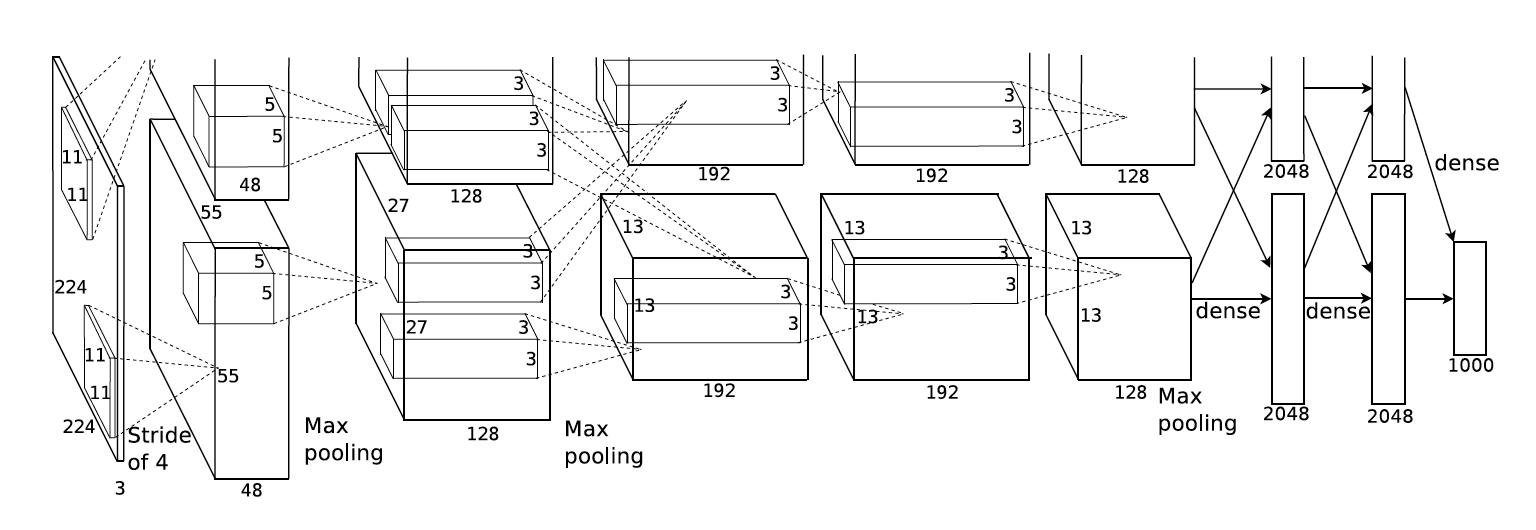AlexNet
2024/2/20大约 2 分钟
AlexNet
本节学习要点
- 了解 AlexNet 网络结构
- 学习
torchvision.transforms.Resize()的使用并拓展到更多torchvision.transforms实例的用法,可以见此处。
网络结构

模型建立
import time
import torch
from torch import nn, optim
import torchvision
import sys
sys.path.append("..")
import d2lzh_pytorch as d2l
device = torch.device('cuda' if torch.cuda.is_available() else 'cpu')
class AlexNet(nn.Module):
def __init__(self):
super(AlexNet, self).__init__()
self.conv = nn.Sequential(
nn.Conv2d(1, 96, 11, 4), # in_channels, out_channels, kernel_size, stride, padding
nn.ReLU(),
nn.MaxPool2d(3, 2), # kernel_size, stride
# 减小卷积窗口,使用填充为 2 来使得输入与输出的高和宽一致,且增大输出通道数
nn.Conv2d(96, 256, 5, 1, 2),
nn.ReLU(),
nn.MaxPool2d(3, 2),
# 连续 3 个卷积层,且使用更小的卷积窗口。除了最后的卷积层外,进一步增大了输出通道数。
# 前两个卷积层后不使用池化层来减小输入的高和宽
nn.Conv2d(256, 384, 3, 1, 1),
nn.ReLU(),
nn.Conv2d(384, 384, 3, 1, 1),
nn.ReLU(),
nn.Conv2d(384, 256, 3, 1, 1),
nn.ReLU(),
nn.MaxPool2d(3, 2)
)
# 这里全连接层的输出个数比 LeNet 中的大数倍。使用丢弃层来缓解过拟合
self.fc = nn.Sequential(
nn.Linear(256*5*5, 4096),
nn.ReLU(),
nn.Dropout(0.5),
nn.Linear(4096, 4096),
nn.ReLU(),
nn.Dropout(0.5),
# 输出层。由于这里使用 Fashion-MNIST,所以用类别数为 10,而非论文中的 1000
nn.Linear(4096, 10),
)
def forward(self, img):
feature = self.conv(img)
output = self.fc(feature.view(img.shape[0], -1))
return output读取数据
为了方便起见,这里不采用 ImageNet 数据集,而是采用较为简单的FashionMNIST数据集,所以需要通过图像增广把图像扩大到 224 的长宽。这里的图像增广需要用torchvision.transforms提供的Resize()实例来实现,并且利用Compose实例与ToTensor()转换器串联,最终读取数据的程序可以优化为:
def load_data_FashionMNIST(batch_size, resize, root="~/Datasets/FashionMNIST"):
trans = [
torchvision.transforms.ToTensor(),
torchvision.transforms.Resize(size=resize),
]
trans = torchvision.transforms.Compose(trans)
train_mnist = torchvision.datasets.FashionMNIST(
root=root, train=True, transform=trans, download=False
)
test_mnist = torchvision.datasets.FashionMNIST(
root=root, train=False, transform=trans, download=False
)
train_iter = torch.utils.data.DataLoader(
train_mnist, batch_size=batch_size, shuffle=True, num_workers=4
)
test_iter = torch.utils.data.DataLoader(
test_mnist, batch_size=batch_size, shuffle=False, num_workers=4
)
return train_iter, test_iter训练模型
main函数
net = AlexNet()
batch_size = 128
resize = 224
lr = 0.001
num_epochs = 5
device = torch.device("cuda")
train_iter, test_iter = load_data_FashionMNIST(batch_size=batch_size, resize=resize)
optimizer = torch.optim.Adam(net.parameters(), lr=lr)
train(net, train_iter, test_iter, optimizer, device, num_epochs)